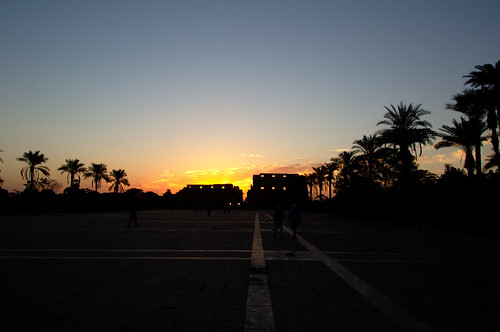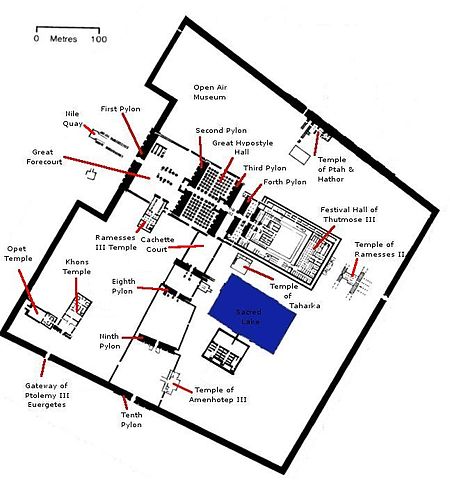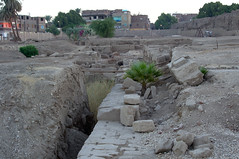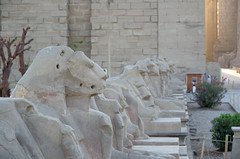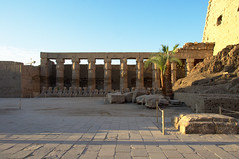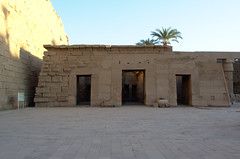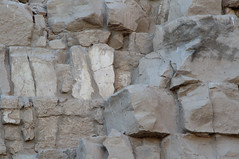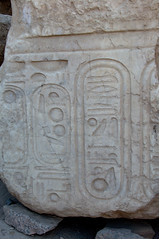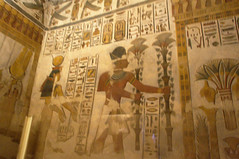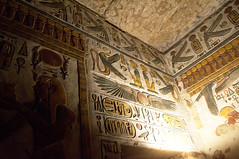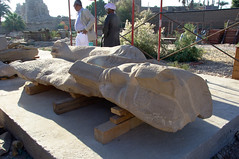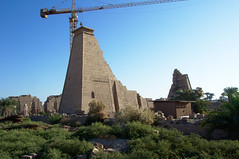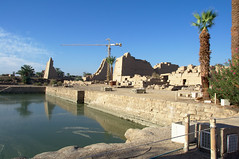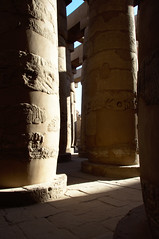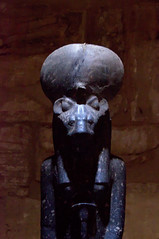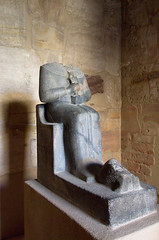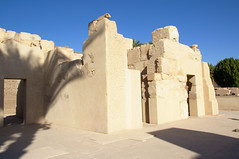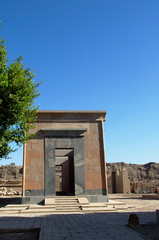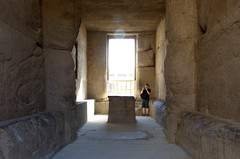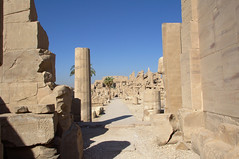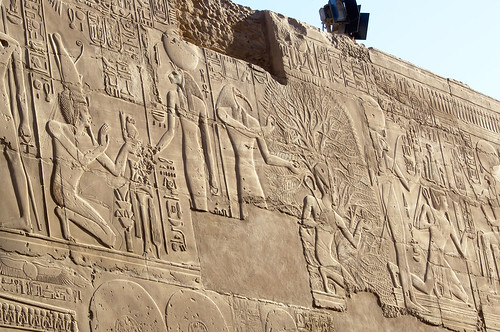Although it’s often referred to as “Karnak Temple” this huge site is actually composed of several temples. The primary one is dedicated to Amun-Ra and was once linked to Luxor Temple (which we visited earlier in the trip) by an avenue of sphinxes. Inside the enclosure walls are several other smaller temples, and to the south outside the walls is the Temple of Mut (which we visited afterwards & I’ll talk about in a separate post). The oldest structure that is still found on the site dates to the Middle Kingdom, but there’s archaeological evidence of occupation dating all the way back to prehistoric times. The various temples (particularly the main one) have been extended and/or rebuilt several times over the millennia that they were in use, making it not only an enormous site but also complicated. The main temple alone is the largest religious structure ever built (according to Kent Weeks’ book about Luxor).
I have a lot of photos from this site – we spent four hours exploring it (and there was a lot we didn’t see!). Only a few are in this post but they are all, as always, on flickr – click here for the full set or on any photo for a larger version.
We started our visit at about 6am, approaching the temple from the west so we got to see the sunrise over the temple. There’s a modern paved plaza in front of the temple entrance and palm trees to left and right, so it looked pretty spectacular. And as we were so early we had the place entirely to ourselves to enjoy it.
After looking at the remains of the avenue of sphinxes at this side of the temple and before we went inside the temple complex itself we paused at the quay in front of the first pylon. Medhat talked a little bit about the excavations that are on going (? or at least recent) in that area. The area was once accessible from the Nile (during flood seasons) and would’ve been used by boats carrying the statue of the god during festivals. The excavations have found evidence of Roman period use of the site, including baths. I think Medhat also told us that there was evidence of a wall or embankment to (attempt to) protect the temple from the occasional serious high floods of the Nile. This can’t’ve been entirely successful – the Kent Weeks’ Luxor book talks about the highest recorded flood flooding the Hypostyle Hall with 33inches of water!
We then went inside and Medhat started what was originally intended to be a “standard” tour of the temple complex, because one of our group (Kay) hadn’t been to Karnak before, but we very quickly got sidetracked. We began by going through the First Pylon (built in the 30th Dynasty) into the first courtyard, labelled Great Forecourt on the plan above (or the First Court in Kent Weeks’s Luxor book which is what I’ve labelled my photos as on flickr). Prior to the building of the First Pylon this had been outside the temple and the avenue of sphinxes had run right up to the Second Pylon. When the First Pylon was built the sphinxes were moved to the edges of the newly formed courtyard – apparently originally they were intended to be reused somewhere else, but instead were just left there. They’ve sat where they are for a couple of thousand years now. In this courtyard we looked at the map of the site that’s here to get a feel for the size of the complex. Medhat explained how it grew over the millennia as various Pharaohs wanted to leave their mark on this sacred site – the oldest bit is the Middle Kingdom Court (not labelled on the plan above, it’s to the left of the Festival Hall of Tutmosis III*). Each addition is built to enlarge the temple as it existed when the Pharaoh ruled – an extra pylon on the front (west) or side (south) or an extra chapel etc.
There are a couple of chapels in the Great Forecourt, including one of Seti II, which we looked at but didn’t go inside. Instead we made our way across to the Second Pylon where Medhat talked about the discoveries that are being made inside it! The pylon was completed by Ramesses II having been begun in the reign of Horemheb. It was built using recycled bits from some building work begun by Akhenaten at Karnak (presumably before he decided that the city of Akhetaten was his new capital). These were the filler inside the Second Pylon and they are being removed with the hope that they can be pieced back together (like other things in the Open Air Museum have been).
And here is where we got sidetracked from the “standard tour” – we were met by the Chief Restorer who took us through to the Temple of Khonsu (or Khons), which was locked up at the time and not open to the general public. So instead of continuing into the Great Hypostyle Hall we turned right through the Bubastite Portal past the Ramesses III temple. The god Khonsu is the third member of the triad that was worshipped at Karnak, he is the son of Amun and Mut in this context. (In other contexts he has other parents, the Ancient Egyptians did not require singular roles for their gods or consistency from their mythology.) His name means “traveller” and he was associated with the moon. The rooms inside his temple at Karnak were in the process of being cleaned and restored when we visited (and I think it’s now finished & open to the public). It was pretty spectacular to see – once cleaned up there is a lot of the original paint remaining which gave a real feel for how these places would’ve looked in their heyday. Instead of the bare stone we see today the walls were white and the carvings were brightly painted. While at this temple Medhat also talked about the inscriptions on the outside of the temple which give us much of our information about the period at the end of the 20th Dynasty. (We heard a talk about this at the EEG shortly after we came home, too – Jennifer Palmer talking about her interpretation of this confusing period.)
After visiting the temple of Khonsu we walked towards the pylons on the north-south axis of the Karnak temple complex. We paused a bit in the area where they store a lot of the pieces of statuary and masonry found on the site and the Chief Restorer showed us (via Medhat’s explanation) a statue that he’s working on which his father discovered decades ago. We then went and looked at the 10th Pylon from the inside – we would see it from the other side later in the morning. It was built by Horemheb and Ramesses II and is the outermost pylon on this axis. We walked back along this axis looking at the pylons as we went. There was quite a bit of reconstruction going on on these pylons and really I only took note of a few details here and there. One of the reliefs had obviously been recarved at some point (in antiquity) as with its paint off as it is now there are very clearly two different crowns on the Pharaoh. One of the pylons was built by Hatshepsut (the Eighth Pylon) and this was actually the first pylon on this axis despite not being the northernmost (the Seventh was built by Tutmosis III afterwards).
We then took a brief look at the Sacred Lake before walking through the Great Hypostyle Hall. Which is never going to get any less awe-inspiring. The columns are just impossibly large and impossibly densely packed. We mostly looked at the reliefs on the northern wall which show Seti I offering to several different gods. As always with anything from Seti I’s reign the art sytle is beautiful.
The next stop on our tour was the Temple of Ptah, which has recently been restored and was about to be re-opened to the public. Inside there were three shrines, and the right hand one had a statue of Sekhmet in it which was lit just by the sunshine through a small high window. The effect was quite eerie although I’m not sure it came out like that in my photograph – Sekhmet is always worth photographing, however 🙂 The central shrine had a partial statue of Ptah in it – not as dramatically lit but still worth seeing. This inner part of the temple was from Tutmosis III’s time, and the area just outside it was much newer – Ptolemaic period. Walking back from this temple to the Open Air Museum we were shown a recently found stone which gives a different name for one of the 17th Dynasty Pharaohs. On this stela he is referred to as Ahmose, and this new information puts him securely into that lineage which was previously not certain. It’s an example of how so much of what we “know” about Ancient Egypt is based only on fragmentary evidence and conjecture that can be overturned by a new discovery.
We didn’t go in the Open Air Museum the first time we visited Karnak, and I think our guide at the time was quite dismissive about it. He was right that quite a lot of it is just bits of masonry or statuary all higgledy-piggledy, which are interesting to archaeologists but not so interesting to me-as-tourist. However, there are also some rather cool reconstructed chapels in there, so I’m glad we visited it this time. These chapels originally functioned as resting places for the god’s barque during ritual processions, and were later dismantled and the blocks reused in other parts of the temple complex. The most famous two (in the sense that I’d heard of them before) are the Red Chapel of Hatshepsut (made of red quartzite & black granite, which is a striking combination) and the White Chapel of Senusret I. The latter has some interesting inscriptions around the outside walls – it lists the nomes (administrative districts of Egypt), their principal deities and the length of their shoreline. So that’s very useful to archaeologists as a snapshot of the political geography of Middle Kingdom Egypt. As well as those two chapels we also looked at the Alabaster Shrine of Amenhotep I, and the White Chapel of Hatshepsut. This last has only very recently been reconstructed, and has a relief that (unusually) portrays Hatshepsut as both ruler & female.
Medhat had finished up his tour at the Open Air Museum, setting us loose to look around first in there and then the rest of the temple. We didn’t have time to look at much more stuff (well, relative to the size of the temple!) so J & I just picked a small handful of things to have a quick look at. After taking a few more pictures in the Great Hypostyle Hall we headed to the barque shrine room in the centre of the main temple axis (to the right of the Fourth Pylon on the plan above). This was absolutely rammed with people when we last visited and I don’t think I even saw inside the room because I couldn’t see over the heads of the crowds. This time we still had the temple almost to ourselves (at nearly 10am) so had a proper look. The shrine is an Alexander era replacement for the Tutmosis III one that previously occupied the same space – Phillip Arrhidaeus (ruler of Egypt at the time, Alexander’s half-brother) claimed he’d found the original shrine in a state of disrepair hence the rebuild. Or he could just’ve been making his mark as the new ruler, in time-honoured Pharaonic fashion! After that we just had long enough to walk through the Middle Kingdom Court to the Tutmosis III Festival Hall. We were looking for the “botanic garden” reliefs, but failed to find them due to a combination of not being sure where we needed to look and not having the time to be thorough in our search.
This visit nicely complemented our last visit to the complex, which had been much more the “standard tour”. It’s hard to convey the scale of the place in words or pictures. I think we could still do another couple (or more!) visits to the site without overlapping very much in what we paid attention to.
